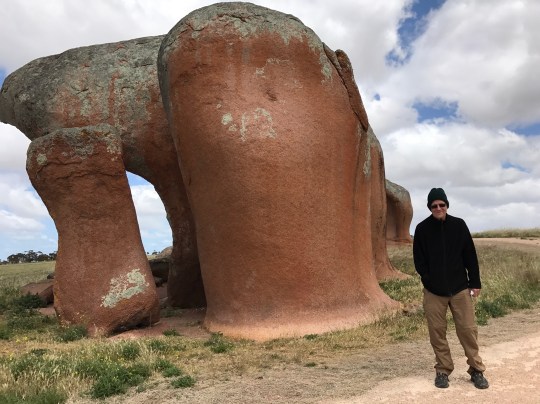Our last views of Esperance were the beautiful beaches along the Great Ocean Drive. We then embarked on four days of driving across the Nullarbor Plains (Null arbor = no trees) and three nights in free camps. This is one of the famous great Australian driving trips. Along the way we saw the Norseman Camels (tin ones), Caiguna Blowhole (just a dirt hole leading to underground caves), the Travellers Cross, the John Eyre memorial and the old Eucla Telegraph Station Ruins (now reclaimed by advancing sand dunes). We drove on ‘The Ninety Mile Straight’ – Australia’s Longest Straight Road (146.6k’s). Did a big cookup of fruit and veg (to meet quarantine conditions) before we crossed the border into South Australia, and then the views picked up significantly. A series of lookouts showcase the Bunda Cliffs and one of our free camps was on the edge of the cliffs. Great sunset views and enough motivation for me to do my second sunrise photo of the trip.
We stopped at the Head of the Bight only to be told that we missed the whales by two days. The Great Australian Bight Marine Park was initially declared in the mid-90’s to protect Southern Right Whales and is now one of the most biologically diverse areas in the world, protecting many species and habitats. That four days of solid driving plus a 2.5 hour time change really tired us out so we spent two nights in Ceduna. We then saw a bit of the Eyre Peninsula coast – Streaky Bay for lunch and Point Labatt, home of the largest mainland population of Australian sea lions. We saw about 30 males, females and pups from the viewing platform
Then we headed inland and had a day of seeing ‘rocks’ (Murphy’s Haystacks, Tcharkulda Rock, and Pildappa Rock) on our way to camp in the Gawler Ranges NP. There we visited the Organ Pipes, orchre red rock formations forged by volcanic activity more than 1500 million years ago. As we were sort of in the area, we next went to Gairdner Lake NP to see Lake Gairdner, Australia’s fourth largest salt lake and the site of numous land speed record attempts when the lake is dry. We walked about 2.5k’s on the lake in a vain attempt to see some water or something but its impossible to get any sense of the distances involved in crossing such a flat, white surface that blends into the horizon. We camped there on our own and in fact didn’t see anyone else for almost 24 hours. It was very remote! Then had another long day of driving with a stop in Kimba where we learned more about John Eyre (the first man to cross the continent from Sydney to the Swan River, heralded as a courageous explorer) and managed to watch a live streaming of Amy’s frisbee nationals final. Ended up camping in Mount Remarkable NP before we drove to Adelaide.
Adelaide was also a social stop; dinner with Tim, lunch with Erica, a bit of shopping and another wash for the van. One final post coming to finish off the series.





























 ‘
‘














